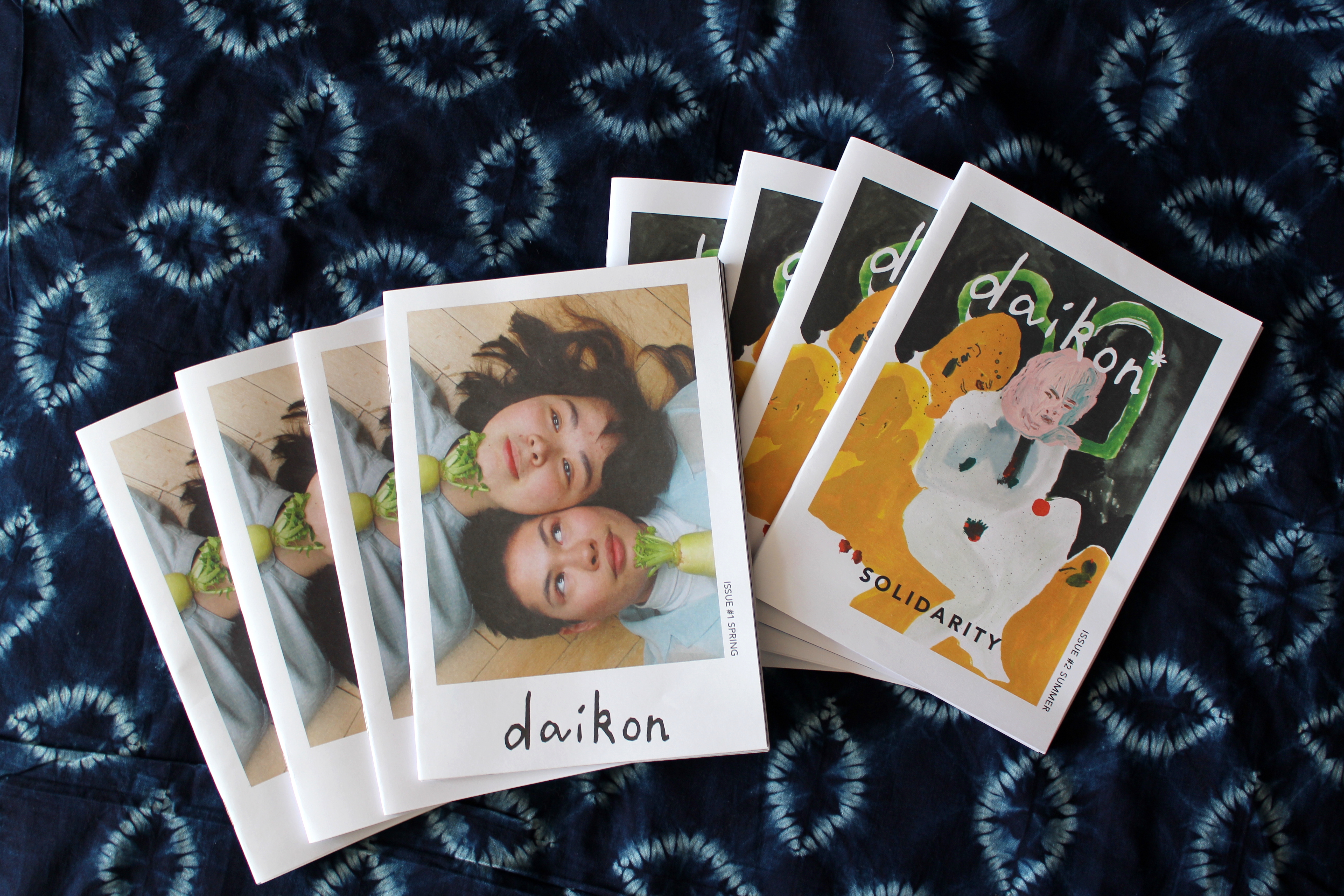For South-East and East Asian women living in Britain, there’s a distinct lack of media discussing issues of race and gender. Lucky, then, that a group of seven London-based South-East and East Asian women – or womxn, the word they use to avoid the suffix “-men” – have created a zine to amplify their experiences.
Daikon* is a print publication for underrepresented Asian voices. The title refers to the widely used vegetable in Asian cuisine, and they chose this as the zine’s name because they feel it’s a unifying symbol for all the different diasporas living in Britain: a strong root everyone can recognise.
Videos by VICE
So far they’ve printed two issues, with their most recent focusing on the theme of “solidarity”. In the works, their third issue is about queer experiences. For this issue, they’re conducting an anonymous online survey about being queer and Asian.
To find out about more the zine, I spoke to four of the Daikon* team.

VICE: How did Daikon* start?
Jess: All of us individually had had conversations about issues surrounding our experiences as Asian women and non-binary people living in London, and, for some us, being mixed-race as well. And then one way or another we all met each other, became friends and started it.
Hanna: While I lived in Cambridge I was part of a women and non-binary people-of-colour group called Fly, where I met my friend Jun. We were discussing that we had no resources in terms of talking about being an Asian person growing up in a predominately white society and how that shapes our identity. We had an idea to create something – anything – like a piece of writing, or a blog, or something to speak about our experiences. And then I met Jade, and Daikon* was born.
Hanna: I think a lot of the political identity of being Asian is Asian-American. When I was trying to think about my identity in terms of race, a lot of resources you have access to are from an American perspective.
Jess: America has a longer and richer history of Asian immigration into the country. Asian-Americans in America are South-East and East Asian people, whereas British-Asian means South Asian people. South-East and East Asian immigration into Britain is all over the place. There is no one place in Britain where all the diaspora is, so in terms of forming communities, there hasn’t been much of a history of it in the UK.
Hanna: I think the history of American-Japanese internment camps sparked a solidarity between them and African-American people. Whereas in the UK there is less of a moment where something specific has happened relating to South-East and East Asian struggles. This makes it hard to organise around anything. You don’t really find anything online about Asian-European experiences.

The zine focuses specifically on women and non-binary people’s experiences. Why did you choose to not include the experiences of Asian men as well?
Jade: If you’re Asian and you’re read as a woman, you’re doubly feminised, and you’re doubly oppressed. It’s a particular area that’s different from other race struggles and other feminist struggles. We were saying when the project started that there was never any feminism for Asian women – that’s why we’re trying to build a voice for it.
Hanna: For our next issue, which will centre around queer and trans experiences, we also want to explicitly talk about more complex relationships to gender and sexuality, non-binary identity and how these interlink with how South-East or East Asians are racialised within the context of Europe.
What are some of the prejudices and expectations society has of Asian women in the UK?
Jess: Some of the things we explore in the zine are how we are gendered as women who aren’t white – so it’s the sexualisation of Asian women and the hyper-feminisation of Asian women, expectations of submissiveness, quietness or politeness.
Jade: I think it makes people feel like they need to conform to femininity earlier or in a certain way.
Hanna: With these kinds of stereotypes of being studious or kind or quiet, I feel like I fit some of them to an extent. But I think that the frustration is that it isn’t just a “Hanna thing”, but a thing because I’m Asian. It takes away your agency to be yourself, because you’re constantly fighting these things, like you need to be more resistant, or more loud, less shy, or worse at maths to prove a point.
Jade: There’s resistance in embracing your stereotypes.

Let’s talk about the name, Daikon*.
Jemma: When we started thinking about names we were contemplating Kimchi-jjigae, which is a Korean stew, because it’s got a hot pot of different ingredients, it’s all cooked together and it’s spicy. We were also thinking of the name Sticky Rice. But everything seemed quite typical to a certain region of somewhere we were trying to bring together. Daikons are widely used in the cuisines of lots of South-East and East Asian countries, and the word translates to “strong root”. It seems like a unifying symbol.
Jess: Originally our name was Daikon, but now it’s Daikon*. After our first issue we had someone write in a critique of why we’d chosen that name because, even though the vegetable is used all over the region, daikon is the Japanese name for it.
Hanna: The purpose of the asterisk is to create a conversation, to highlight the fact that it’s called Daikon*, and make you think, ‘Why’s there an asterisk?’ Inside the zine there is all the other names for daikon from the region. We want to raise awareness and be critical of how Japan is centred within the collectivity of South-East and East Asians, partly because of its colonial history, and when you read the zine you should also be thinking about that.




